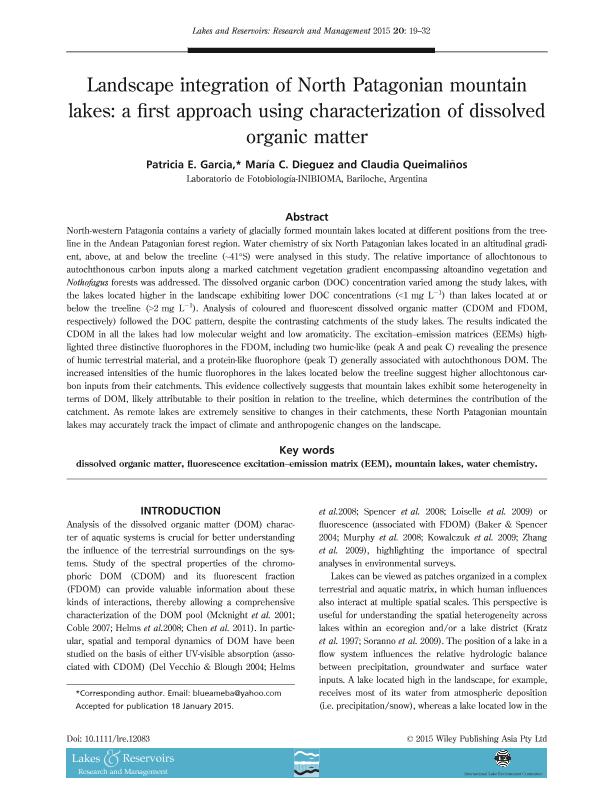Mostrar el registro sencillo del ítem
dc.contributor.author
Garcia, Patricia Elizabeth

dc.contributor.author
Dieguez, Maria del Carmen

dc.contributor.author
Queimaliños, Claudia Patricia

dc.date.available
2017-01-26T18:34:25Z
dc.date.issued
2015-03
dc.identifier.citation
Garcia, Patricia Elizabeth; Dieguez, Maria del Carmen; Queimaliños, Claudia Patricia; Landscape integration of North Patagonian mountain lakes: a first approach using characterization of dissolved organic matter; Wiley Publishing Asia; Lakes & Reservoirs: Research & Management; 20; 1; 3-2015; 19-32
dc.identifier.issn
1440-1770
dc.identifier.uri
http://hdl.handle.net/11336/11989
dc.description.abstract
North-western Patagonia contains a variety of glacially formed mountain lakes located at different positions from the treeline in the Andean Patagonian forest region. Water chemistry of six North Patagonian lakes located in an altitudinal gradient, above, at and below the treeline (~41°S) were analysed in this study. The relative importance of allochtonous to autochthonous carbon inputs along a marked catchment vegetation gradient encompassing altoandino vegetation and Nothofagus forests was addressed. The dissolved organic carbon (DOC) concentration varied among the study lakes, with the lakes located higher in the landscape exhibiting lower DOC concentrations (<1 mg L−1) than lakes located at or below the treeline (>2 mg L−1). Analysis of coloured and fluorescent dissolved organic matter (CDOM and FDOM, respectively) followed the DOC pattern, despite the contrasting catchments of the study lakes. The results indicated the CDOM in all the lakes had low molecular weight and low aromaticity. The excitation–emission matrices (EEMs) highlighted three distinctive fluorophores in the FDOM, including two humic-like (peak A and peak C) revealing the presence of humic terrestrial material, and a protein-like fluorophore (peak T) generally associated with autochthonous DOM. The increased intensities of the humic fluorophores in the lakes located below the treeline suggest higher allochtonous carbon inputs from their catchments. This evidence collectively suggests that mountain lakes exhibit some heterogeneity in terms of DOM, likely attributable to their position in relation to the treeline, which determines the contribution of the catchment. As remote lakes are extremely sensitive to changes in their catchments, these North Patagonian mountain lakes may accurately track the impact of climate and anthropogenic changes on the landscape.
dc.format
application/pdf
dc.language.iso
eng
dc.publisher
Wiley Publishing Asia
dc.rights
info:eu-repo/semantics/openAccess
dc.rights.uri
https://creativecommons.org/licenses/by-nc-sa/2.5/ar/
dc.subject
Dissolved Organic Matter
dc.subject
Fluorescence Excitation? Emission Matrix (Eem)
dc.subject
Mountain Lakes
dc.subject
Water Chemistry
dc.subject.classification
Oceanografía, Hidrología, Recursos Hídricos

dc.subject.classification
Ciencias de la Tierra y relacionadas con el Medio Ambiente

dc.subject.classification
CIENCIAS NATURALES Y EXACTAS

dc.title
Landscape integration of North Patagonian mountain lakes: a first approach using characterization of dissolved organic matter
dc.type
info:eu-repo/semantics/article
dc.type
info:ar-repo/semantics/artículo
dc.type
info:eu-repo/semantics/publishedVersion
dc.date.updated
2016-12-12T14:32:46Z
dc.journal.volume
20
dc.journal.number
1
dc.journal.pagination
19-32
dc.journal.pais
Singapur

dc.description.fil
Fil: Garcia, Patricia Elizabeth. Consejo Nacional de Investigaciones Científicas y Técnicas. Centro Científico Tecnológico Patagonia Norte. Instituto de Investigación En Biodiversidad y Medioambiente; Argentina. Universidad Nacional del Comahue. Centro Regional Universitario Bariloche. Laboratorio de Fotobiologia; Argentina
dc.description.fil
Fil: Dieguez, Maria del Carmen. Consejo Nacional de Investigaciones Científicas y Técnicas. Centro Científico Tecnológico Patagonia Norte. Instituto de Investigación En Biodiversidad y Medioambiente; Argentina. Universidad Nacional del Comahue. Centro Regional Universitario Bariloche. Laboratorio de Fotobiologia; Argentina
dc.description.fil
Fil: Queimaliños, Claudia Patricia. Consejo Nacional de Investigaciones Científicas y Técnicas. Centro Científico Tecnológico Patagonia Norte. Instituto de Investigación En Biodiversidad y Medioambiente; Argentina. Universidad Nacional del Comahue. Centro Regional Universitario Bariloche. Laboratorio de Fotobiologia; Argentina
dc.journal.title
Lakes & Reservoirs: Research & Management
dc.relation.alternativeid
info:eu-repo/semantics/altIdentifier/url/http://onlinelibrary.wiley.com/doi/10.1111/lre.12083/abstract
dc.relation.alternativeid
info:eu-repo/semantics/altIdentifier/doi/http://dx.doi.org/10.1111/lre.12083
Archivos asociados
